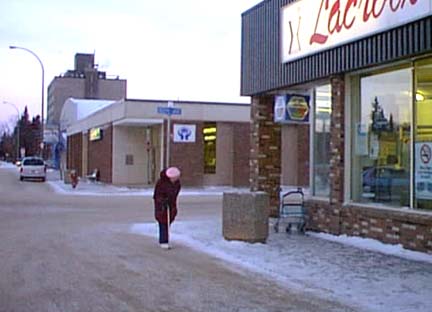Watch Your Step
 FTLComm
- Tisdale
FTLComm
- TisdaleJanuary 6, 1999
Dangerous conditions develop over the course of the winter so that some days it is extremely dangerous as road and walking surfaces become glazed Very low temperatures tend to improve things but a slight warming can create uneven footing.
Tuesday it was noticed that getting around on foot was extremely difficult not only for senior citizens and those with canes and walkers but for everyone. One lady leaving the post office was wearing crampons, not unlike those worn by mountain climbers. These devices affixed to one shoes might offer some improved traction but would depend upon the person's weight to make them
effective and on pavement and cement might even reduce traction. The best footwear
for very slippery conditions are "broomball" shoes designed with spongy
soles but hardly practical for most senior citizens. The best advise we can give
is to remember what you were told when you were learning to skate.
| 1. |
Lower your body's centre of gravity and move it slightly forward to prevent toppling backward. To achieve this widen your stance (feet apart, left to right) bend your knees and lean ahead. This stance will give you a better chance and reduce the distance you have to fall. It also moves your body's weight over top of the balls of your feet. |
| 2. | If you use a cane or walking stick see that its contact end is sharp and can stick in. There are special ends that can be applied to increase its effectiveness in icy conditions. |
| 3. |
Dress warmly. Clutching at your neck to hold your coat closed takes one hand which should be available for balance or to break a fall. Similarly, do not carry anything in your hands, put whatever you can in your pockets or wear a pack thus leaving your hands free. That handy big purse ladies is better left at home then getting in your way. |
| 4. |
Should you fall try to induce a roll so that the fall does not impact on a single area but is spread out as your motion moves to into contact with the ground laterally rather then straight down. A straight fall from upright position can easily break a wrist, hip or arm but a rolling fall will result only in your momentary loss of dignity which will be readily regained once you realise that there was no damage done. |
| 5. |
You are most vulnerable getting into and out of a car. Parking areas will have the least traction available and the surface almost always tends to slope toward the place where the car is stopped. Take your time, make sure you have some footing before you attempt to stand and whenever possible wait for assistance a steadying hand could prevent you from spending a week or so in the hospital. |
